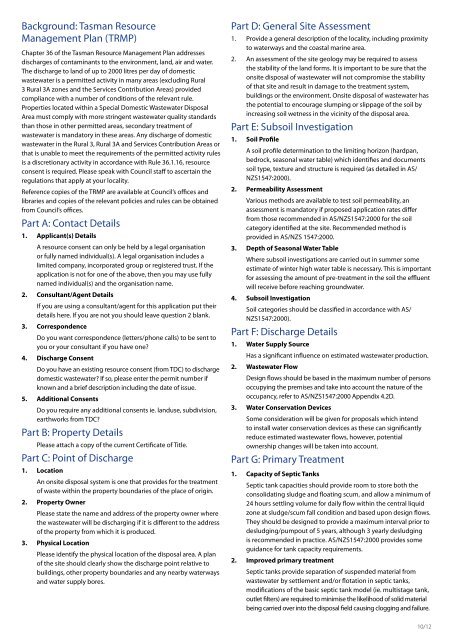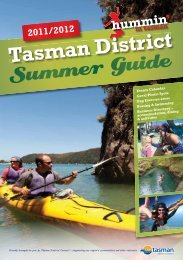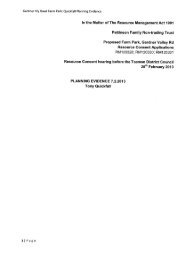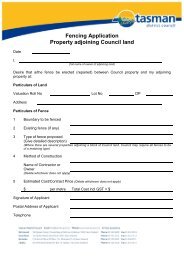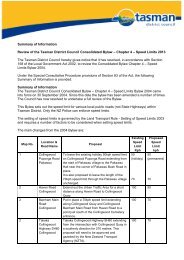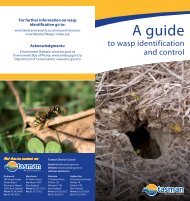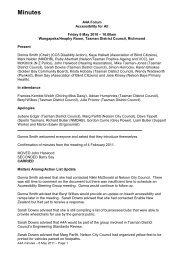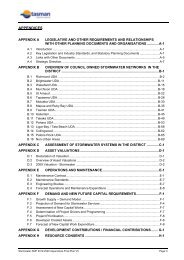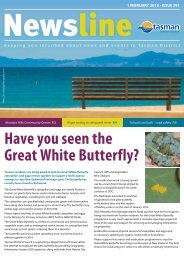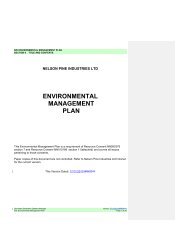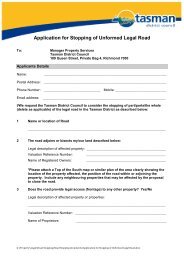Application For Resource Consent To Discharge Domestic ...
Application For Resource Consent To Discharge Domestic ...
Application For Resource Consent To Discharge Domestic ...
Create successful ePaper yourself
Turn your PDF publications into a flip-book with our unique Google optimized e-Paper software.
Background: Tasman <strong>Resource</strong><br />
Management Plan (TRMP)<br />
Chapter 36 of the Tasman <strong>Resource</strong> Management Plan addresses<br />
discharges of contaminants to the environment, land, air and water.<br />
The discharge to land of up to 2000 litres per day of domestic<br />
wastewater is a permitted activity in many areas (excluding Rural<br />
3 Rural 3A zones and the Services Contribution Areas) provided<br />
compliance with a number of conditions of the relevant rule.<br />
Properties located within a Special <strong>Domestic</strong> Wastewater Disposal<br />
Area must comply with more stringent wastewater quality standards<br />
than those in other permitted areas, secondary treatment of<br />
wastewater is mandatory in these areas. Any discharge of domestic<br />
wastewater in the Rural 3, Rural 3A and Services Contribution Areas or<br />
that is unable to meet the requirements of the permitted activity rules<br />
is a discretionary activity in accordance with Rule 36.1.16, resource<br />
consent is required. Please speak with Council staff to ascertain the<br />
regulations that apply at your locality.<br />
Reference copies of the TRMP are available at Council’s offices and<br />
libraries and copies of the relevant policies and rules can be obtained<br />
from Council’s offices.<br />
Part A: Contact Details<br />
1. Applicant(s) Details<br />
A resource consent can only be held by a legal organisation<br />
or fully named individual(s). A legal organisation includes a<br />
limited company, incorporated group or registered trust. If the<br />
application is not for one of the above, then you may use fully<br />
named individual(s) and the organisation name.<br />
2. Consultant/Agent Details<br />
If you are using a consultant/agent for this application put their<br />
details here. If you are not you should leave question 2 blank.<br />
3. Correspondence<br />
Do you want correspondence (letters/phone calls) to be sent to<br />
you or your consultant if you have one?<br />
4. <strong>Discharge</strong> <strong>Consent</strong><br />
Do you have an existing resource consent (from TDC) to discharge<br />
domestic wastewater? If so, please enter the permit number if<br />
known and a brief description including the date of issue.<br />
5. Additional <strong>Consent</strong>s<br />
Do you require any additional consents ie. landuse, subdivision,<br />
earthworks from TDC?<br />
Part B: Property Details<br />
Please attach a copy of the current Certificate of Title.<br />
Part C: Point of <strong>Discharge</strong><br />
1. Location<br />
An onsite disposal system is one that provides for the treatment<br />
of waste within the property boundaries of the place of origin.<br />
2. Property Owner<br />
Please state the name and address of the property owner where<br />
the wastewater will be discharging if it is different to the address<br />
of the property from which it is produced.<br />
3. Physical Location<br />
Please identify the physical location of the disposal area. A plan<br />
of the site should clearly show the discharge point relative to<br />
buildings, other property boundaries and any nearby waterways<br />
and water supply bores.<br />
Part D: General Site Assessment<br />
1. Provide a general description of the locality, including proximity<br />
to waterways and the coastal marine area.<br />
2. An assessment of the site geology may be required to assess<br />
the stability of the land forms. It is important to be sure that the<br />
onsite disposal of wastewater will not compromise the stability<br />
of that site and result in damage to the treatment system,<br />
buildings or the environment. Onsite disposal of wastewater has<br />
the potential to encourage slumping or slippage of the soil by<br />
increasing soil wetness in the vicinity of the disposal area.<br />
Part E: Subsoil Investigation<br />
1. Soil Profile<br />
A soil profile determination to the limiting horizon (hardpan,<br />
bedrock, seasonal water table) which identifies and documents<br />
soil type, texture and structure is required (as detailed in AS/<br />
NZS1547:2000).<br />
2. Permeability Assessment<br />
Various methods are available to test soil permeability, an<br />
assessment is mandatory if proposed application rates differ<br />
from those recommended in AS/NZS1547:2000 for the soil<br />
category identified at the site. Recommended method is<br />
provided in AS/NZS 1547:2000.<br />
3. Depth of Seasonal Water Table<br />
Where subsoil investigations are carried out in summer some<br />
estimate of winter high water table is necessary. This is important<br />
for assessing the amount of pre-treatment in the soil the effluent<br />
will receive before reaching groundwater.<br />
4. Subsoil Investigation<br />
Soil categories should be classified in accordance with AS/<br />
NZS1547:2000).<br />
Part F: <strong>Discharge</strong> Details<br />
1. Water Supply Source<br />
Has a significant influence on estimated wastewater production.<br />
2. Wastewater Flow<br />
Design flows should be based in the maximum number of persons<br />
occupying the premises and take into account the nature of the<br />
occupancy, refer to AS/NZS1547:2000 Appendix 4.2D.<br />
3. Water Conservation Devices<br />
Some consideration will be given for proposals which intend<br />
to install water conservation devices as these can significantly<br />
reduce estimated wastewater flows, however, potential<br />
ownership changes will be taken into account.<br />
Part G: Primary Treatment<br />
1. Capacity of Septic Tanks<br />
Septic tank capacities should provide room to store both the<br />
consolidating sludge and floating scum, and allow a minimum of<br />
24 hours settling volume for daily flow within the central liquid<br />
zone at sludge/scum fall condition and based upon design flows.<br />
They should be designed to provide a maximum interval prior to<br />
desludging/pumpout of 5 years, although 3 yearly desludging<br />
is recommended in practice. AS/NZS1547:2000 provides some<br />
guidance for tank capacity requirements.<br />
2. Improved primary treatment<br />
Septic tanks provide separation of suspended material from<br />
wastewater by settlement and/or flotation in septic tanks,<br />
modifications of the basic septic tank model (ie. multistage tank,<br />
outlet filters) are required to minimise the likelihood of solid material<br />
being carried over into the disposal field causing clogging and failure.<br />
10/12


